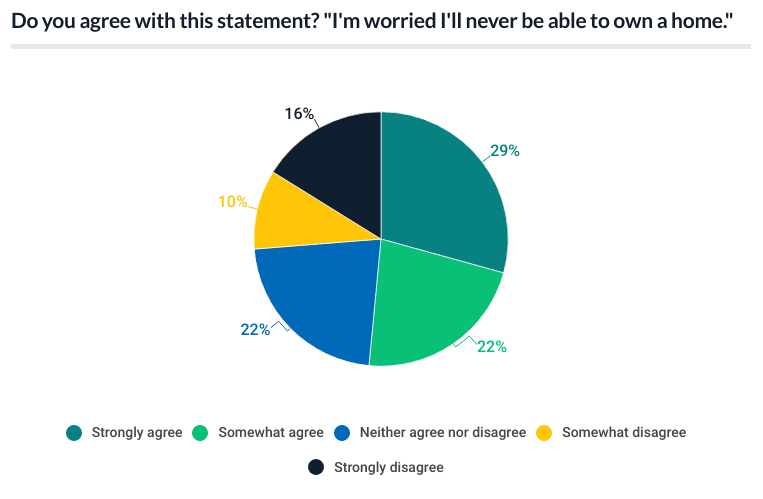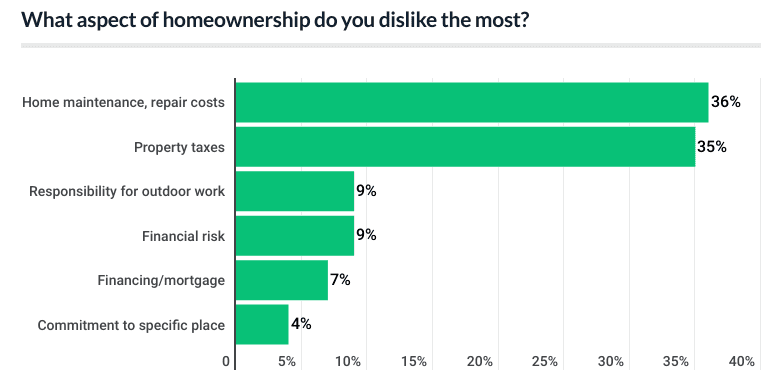While owning a home has been seen as a sign of success, otherwise known as a quintessential part of achieving the American dream, the path to homeownership remains a tough one for many Americans.
Although 84% of Americans say they’d like to own a home one day, some 51% of Americans who don’t currently own a home fear that they never will. That's according to a new survey from LendingTree [1].
Key Findings:
- For those who rent, the path to homeownership is full of challenges. Among those who would own a home in an ideal world but don’t now, 49% say they can’t afford a down payment and 40% say home prices are too high in their area. Student loan debt weighs heaviest on millennials, with 19% citing it as a roadblock to homeownership. They’re also the generation most concerned about interest rates, at 41%.
- Those who want to own a home crave the stability and flexibility homeownership offers. Of the 84% who’d rather own a home than rent, nearly 3 in 5 (59%) say they like the flexibility to do whatever they want with the space—that’s just ahead of not having to worry about renewing a lease (58%) as the top reason to prefer homeownership. Being proud of homeownership (49%) and expecting a home to increase in value (47%) are also among the top-cited reasons for buying a home.
- Both renting and homeownership have their drawbacks. Home maintenance and repair costs are the No. 1 aspect homeowners dislike about their decision to buy, at 36%; property taxes (35%) are a close second. Among renters, 30% say the worst part about their current situation is the unexpected rent increases, followed by having to deal with a landlord (22%).

"While homeownership can be a great goal to strive for, there are more important things in life,” said LendingTree senior economist Jacob Channel. “If you’re in a position where you can afford it and are willing to take on the responsibilities of homeownership, buying can be well worth it. But if you’re not in a position to buy, you shouldn’t be too hard on yourself.”
Homeowners are more satisfied with their housing situation than renters
Most Americans think homeownership is a key milestone. In fact, 94% of consumers say owning a home is part of the American dream—though 38% of this group say it’s less important than it used to be. And not all consumers consider it a personal goal, either: Just 84% say they’d own a home in an ideal world.
Among Gen Zers (ages 18 to 26), just 75% say they’d rather own a home than rent—the least of any group. That compares with:
- Some 84% of millennials (ages 27 to 42)
- An estimated 84% of Gen Xers (ages 43 to 58)
- Approximately 89% of baby boomers (ages 59 to 77)
Men (88%) are much more likely to dream of homeownership than women (80%). In addition, some consumers may think about what homeownership would mean for their kids, as those with children younger than 18 (89%) and those with adult children (88%) are far more likely to say they’d rather own a home than consumers without children (76%).
High-income consumers are more likely to set their sights on homeownership. Six-figure earners (96%) are the most likely group to say they’d rather own than rent, while those earning less than $35,000 (72%) are the least likely.

“There’s no getting around how tough buying a home can be in today’s high interest rates and high price housing market,” said Channel. “As tough as it may seem, those who want to buy but can’t afford to right now should try to keep hope. The more time you give yourself to do things like save for a down payment and work on your credit score, the more likely you’ll be able to buy one day.”
There’s a good reason that owning a home is considered an American dream: Those who own are generally happier. While just 51% of renters say they’re satisfied with their current housing situation, 82% of homeowners feel the same.
Majority of Americans who don't currently own a home fear they never will
By generation, millennials who don’t own a home are the most worried about their chances of doing so at 60%. That compares with:
- Some 51% of Gen Zers
- An estimated 51% of Gen Xers
- Approximately 36% of baby boomers
Those with children younger than 18 (61%) are much more likely to worry than those without children (49%) and those with children 18 and older (43%).
Among those who would own a home if they could, some 49% say they can’t afford a down payment, making it the top reason. Following down payments, 40% say home prices are too high in their respective areas. Meanwhile, 31% say rates are too high.
Some Americans prefer renting to buying a home
While many Americans are shooting for the American dream, not everyone sees the appeal. Some 16% of respondents say they prefer to rent, while 42% say they enjoy not being responsible for maintenance or repair costs—making it the top reason.
Finances are another factor, as more than a third (37%) of Americans say it’s more affordable to rent, while 36% say they like not having to pay property taxes. Meanwhile, some 31% say renting offers more peace of mind than ownership.
“While owning a home may be part of most people’s American dream, there’s nothing wrong with renting instead,” said Channel. “Renting is often cheaper than owning. Not only that, renters also tend to have more freedom to move around than homeowners. After all, it’s generally easier to pack up and go when your lease expires than it is to go through the hassle of selling a house.”
To read the full report, including more data, charts, and methodology, click here [1].